June is Brain Injury Awareness month in Canada with the objective being to highlight awareness on the effects and causes of acquired brain injury. In the United States March is the designated month for Brain Injury Awareness. As I mentioned in last week’s newsletter, I will use this as my theme for all my blogs this month with my hope being that each one will give you a greater, more broader, understanding of the social, economical and healthcare consequences of a brain injury in addition to the personal impact it can have on an individual.
Did you know that currently around 10% of the total world’s population, or roughly 650 million people, live with a disability, making it the world’s largest minority group?
To set the scene I felt it would be useful to share a few grim stats with you surrounding the prevalence of traumatic brain injury within North America:
Canada:
1. Each year more than 11,000 Canadians die as a result of traumatic brain injury.
2. Each year more than 6,000 Canadians become permanently disabled. after traumatic brain injury.
3. Approximately 1.5 million people in Canada are living with a brain injury.
4. 452 people sustain a brain injury every day in Canada, which works out to one traumatic brain injury every 3 minutes.
5. While brain injury affects every segment of the population, the most affected are young males age 18 to 35.
6. Direct and indirect costs associated with traumatic brain injury are estimated at $3 billion annually across Canada. The total economical costs are estimated to be over $12 billion each year.
In the US, the stats are just are bleak:
 1. 5.3 million Americans live with a long-term disability as a result of traumatic brain injury, which works out to 1 in every 60 Americans.
1. 5.3 million Americans live with a long-term disability as a result of traumatic brain injury, which works out to 1 in every 60 Americans.
2. 75% of traumatic brain injuries are classified as mild (concussion).
3. Traumatic brain injury is a contributing factor to one third (33%) of all injury related deaths.
4. In 2010 approximately 2.5 million Americans sustained a traumatic brain injury.
5. Every day 138 people in the US die from injuries that include traumatic brain injury.
6. The estimated economical cost of a TBI in 2010 was $76.5 billion dollars, including direct and indirect costs (and this is not a typo!)
I’m not sure what is more shocking, the high economical costs associated with traumatic brain injury across North America or the medically supported fact that over 80% of all traumatic brain injuries are preventable.
What’s the difference between TBI and ABI?
Chances are you may feel a bit confused when you see words like traumatic brain injury (TBI), acquired brain injury (ABI) and concussion being used interchangeably in conversations or in reading materials, I know I once found it this way myself. For clarification, I thought it would be useful to spell out what each mean as defined by Brain Injury Canada. These definitions are universal across the globe:
An acquired brain injury is an injury to the brain that is not hereditary, congenital, degenerative or induced by birth trauma.
An acquired brain injury can include traumatic or non-traumatic events. A traumatic brain injury (TBI) is an injury to the brain caused by an external force, such as:
– A sports injury
– A motor vehicle crash
– A fall
– An assault
– A gunshot wound
Non-traumatic brain injury is an internal injury to the brain itself that can be the result of:
– A stroke
– Loss of oxygen to the brain
– Meningitis
A concussion, often referred to as a mild traumatic brain injury, is caused by a jolt, blow or bump to the head or body that causes the brain to move back and forth in your skull. A concussion often changes the way your brain works and can cause a multitude of impacts on the rest of your body with such symptoms as:
– Amnesia
– Confusion
– Headache
– Loss of consciousness
– Balance problems or dizziness
– Double of blurry vision
– Sensitivity to light or noise
– Nausea
– Feeling groggy or sluggish
– Feeling unusually irritable
– Concentration or memory problems
– Delayed reaction time
Concussions can be extremely difficult to diagnose as often times there are no outer physical signs and many of the symptoms I’ve noted above can frequently take up one week to appear.
Someone may fall hiking and hit their head on a tree, pick themselves up not realize that the headache that appears later on or the fact that their balance feels a bit off or they become a bit irritable may actually be due to having experienced a concussion. A loss of consciousness, which most people commonly associate with having a concussion, only occurs in about 10% of all cases.
Impact
Brain injuries, and the resulting impacts, are as unique to each individual as is the prognosis once rehabilitation begins. The brain is a very complex organ and there are many factors that can play a part in the severity of the injury and long-term impact. What I can say is that the residual effects are likely to include a complex variety of physical, cognitive and behavioral problems. Cognitive difficulties are not always obvious yet can have devastating consequences for the individual (social interactions, work, communication, etc.) as well as those around her/him.
Stay tuned for part two in the series where I will delve into the effects of concussions. What you find out may surprise you.
*All statistics in the above email originate from the Brain Injury Society of America, the Centers for Disease Control & Prevention and Brain Injury Canada.












The information being shared is a great help for us in learning more about brain injuries.